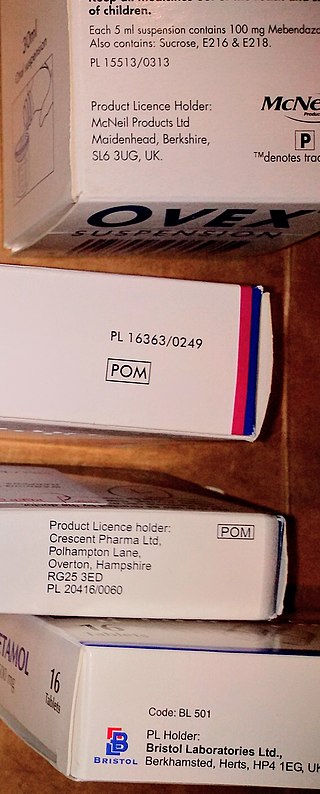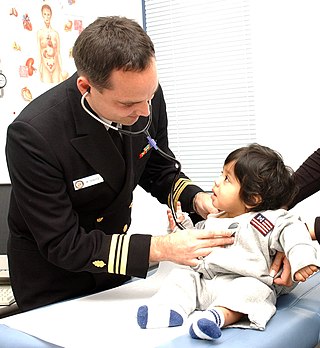Related Research Articles

The Controlled Substances Act (CSA) is the statute establishing federal U.S. drug policy under which the manufacture, importation, possession, use, and distribution of certain substances is regulated. It was passed by the 91st United States Congress as Title II of the Comprehensive Drug Abuse Prevention and Control Act of 1970 and signed into law by President Richard Nixon. The Act also served as the national implementing legislation for the Single Convention on Narcotic Drugs.

The International Standard Book Number (ISBN) is a numeric commercial book identifier that is intended to be unique. Publishers purchase or receive ISBNs from an affiliate of the International ISBN Agency.

A prescription, often abbreviated ℞ or Rx, is a formal communication from a physician or other registered healthcare professional to a pharmacist, authorizing them to dispense a specific prescription drug for a specific patient. Historically, it was a physician's instruction to an apothecary listing the materials to be compounded into a treatment—the symbol ℞ comes from the first word of a medieval prescription, Latin: Recipere, that gave the list of the materials to be compounded.

A prescription drug is a pharmaceutical drug that is permitted to be dispensed only to those with a medical prescription. In contrast, over-the-counter drugs can be obtained without a prescription. The reason for this difference in substance control is the potential scope of misuse, from drug abuse to practicing medicine without a license and without sufficient education. Different jurisdictions have different definitions of what constitutes a prescription drug.
Oxycodone/paracetamol, sold under the brand name Percocet among others, is a fixed-dose combination of the opioid oxycodone with paracetamol (acetaminophen), used to treat moderate to severe pain.
Drug diversion is a medical and legal concept involving the transfer of any legally prescribed controlled substance from the individual for whom it was prescribed to another person for any illicit use. The definition varies slightly among different jurisdictions, but the transfer of a controlled substance alone usually does not constitute a diversion, since certain controlled substances that are prescribed to a child are intended to be administered by an adult, as directed by a medical professional. The term comes from the "diverting" of the drugs from their original licit medical purpose. In some jurisdictions, drug diversion programs are available to first time offenders of diversion drug laws, which "divert" offenders from the criminal justice system to a program of education and rehabilitation.

Off-label use is the use of pharmaceutical drugs for an unapproved indication or in an unapproved age group, dosage, or route of administration. Both prescription drugs and over-the-counter drugs (OTCs) can be used in off-label ways, although most studies of off-label use focus on prescription drugs.
A national identification number, national identity number, or national insurance number or JMBG/EMBG is used by the governments of many countries as a means of tracking their citizens, permanent residents, and temporary residents for the purposes of work, taxation, government benefits, health care, and other governmentally-related functions.

A nurse practitioner (NP) is an advanced practice registered nurse and a type of mid-level practitioner. NPs are trained to assess patient needs, order and interpret diagnostic and laboratory tests, diagnose disease, formulate and prescribe medications and treatment plans. NP training covers basic disease prevention, coordination of care, and health promotion, but does not provide the depth of expertise needed to recognize more complex conditions.

The Comprehensive Drug Abuse Prevention and Control Act of 1970, Pub. L. 91–513, 84 Stat. 1236, enacted October 27, 1970, is a United States federal law that, with subsequent modifications, requires the pharmaceutical industry to maintain physical security and strict record keeping for certain types of drugs. Controlled substances are divided into five schedules on the basis of their potential for abuse, accepted medical use, and accepted safety under medical supervision. Substances in Schedule I have a high potential for abuse, no accredited medical use, and a lack of accepted safety. From Schedules II to V, substances decrease in potential for abuse. The schedule a substance is placed in determines how it must be controlled. Prescriptions for drugs in all schedules must bear the physician's federal Drug Enforcement Administration (DEA) license number, but some drugs in Schedule V do not require a prescription. State schedules may vary from federal schedules.
A National Provider Identifier (NPI) is a unique 10-digit identification number issued to health care providers in the United States by the Centers for Medicare and Medicaid Services (CMS). The NPI has replaced the Unique Physician Identification Number (UPIN) as the required identifier for Medicare services, and is used by other payers, including commercial healthcare insurers. The transition to the NPI was mandated as part of the Administrative Simplifications portion of the Health Insurance Portability and Accountability Act of 1996 (HIPAA).
An online pharmacy, internet pharmacy, or mail-order pharmacy is a pharmacy that operates over the Internet and sends orders to customers through mail, shipping companies, or online pharmacy web portal.
Mid-level practitioners, also called non-physician practitioners, advanced practice providers, or commonly mid-levels are health care providers who assess, diagnose, and treat patients but do not have as extensive of an education as a physician. The scope of a mid-level practitioner varies greatly between countries and even between individual practitioners. Some mid-level practitioners work closely under the supervision of a physician, while others function independently and have a scope of practice difficult to distinguish from a physician. The legal scope of practice for mid-level practitioners varies greatly between jurisdiction, with some having a restricted and well-defined scope, while others have a scope similar to that of a physician. Likewise, the training requirement for mid-level practitioners varies greatly between and within different certifications and licensures.
The Drug Addiction Treatment Act of 2000, Title XXXV, Section 3502 of the Children's Health Act, permits physicians who meet certain qualifications to treat opioid addiction with Schedule III, IV, and V narcotic medications that have been specifically approved by the Food and Drug Administration for that indication.
The Ohio Automated Rx Reporting System (OARRS) is Ohio's state Prescription Monitoring Program (PMP) and is controlled by the Ohio State Board of Pharmacy. The law permitting the Board of Pharmacy to create the PMP was signed on March 18, 2005, and became effective January 1, 2006. The OARRS program began operation on October 2, 2006. The law is available to read in the Drug Laws of Ohio pages C-50 through C-54. The Ohio State Board of Pharmacy is responsible for collecting and verifying data for prescriptions that the Drug Enforcement Administration (DEA) classifies Schedule II-V as well as carisoprodol and tramadol prescriptions.
In the United States, prescription monitoring programs (PMPs) or prescription drug monitoring programs (PDMPs) are state-run programs which collect and distribute data about the prescription and dispensation of federally controlled substances and, depending on state requirements, other potentially abusable prescription drugs. PMPs are meant to help prevent adverse drug-related events such as opioid overdoses, drug diversion, and substance abuse by decreasing the amount and/or frequency of opioid prescribing, and by identifying those patients who are obtaining prescriptions from multiple providers or those physicians overprescribing opioids.
The Health Industry Business Communications Council (HIBCC) is a primary standard-setting and educational organization for healthcare bar coding in the United States. It provides publications, trade shows, educational resources, conferences and training programs.
Practicing without a license is the act of working without the licensure offered for that occupation, in a particular jurisdiction. Most activities that require licensure also have penalties for practicing without a valid, current license. In some jurisdictions, a license is offered but not required for some professions.
Advanced Practice Registered Nurse (APRN) refers to a nurse with advanced education, typically at least a master's degree, and certification by a national certifying program. The APRN provides specialized and multifaceted care and are able to do 60 to 80 percent of preventative and primary care done by physicians. Minnesota Statutes section 148.171, subd. 3 states that in Minnesota, APRN "means an individual licensed as a registered nurse by the board, and certified by a national nurse certification organization acceptable to the board to practice as a clinical nurse specialist, nurse anesthetist, nurse midwife, or nurse practitionerr".

In the United States, the opioid epidemic is an extensive ongoing overuse of opioid medications, both from medical prescriptions and illegal sources. The epidemic began in the United States in the late 1990s, according to the Centers for Disease Control and Prevention (CDC), when opioids were increasingly prescribed for pain management, resulting in a rise in overall opioid use throughout subsequent years. The great majority of Americans who use prescription opioids do not believe that they are misusing them.
References
- ↑ "Miscellaneous Questions / Security". Archived from the original on 20 January 2017. Retrieved 9 Feb 2017.
- ↑ "DEA Numbers Definition and Construction". August 27, 2008. Archived from the original on 2016-12-21.
- ↑ "Pharmacist's Manual - SECTION IX-XIV: Section IX – Valid Prescription Requirements". U.S. Department of Justice: Diversion Control Division. Archived from the original on April 17, 2019. Retrieved June 26, 2019.
- ↑ http://www.deadiversion.usdoj.gov/drugreg/reg_apps/new_reg_number110906.html%5B%5D "Due to the large Type A (Practitioner) registrant population, the initial alpha letter "B" has been exhausted. DEA will begin using the new alpha letter "F" as the initial character for all new registration for Type A (Practitioner) registrations."